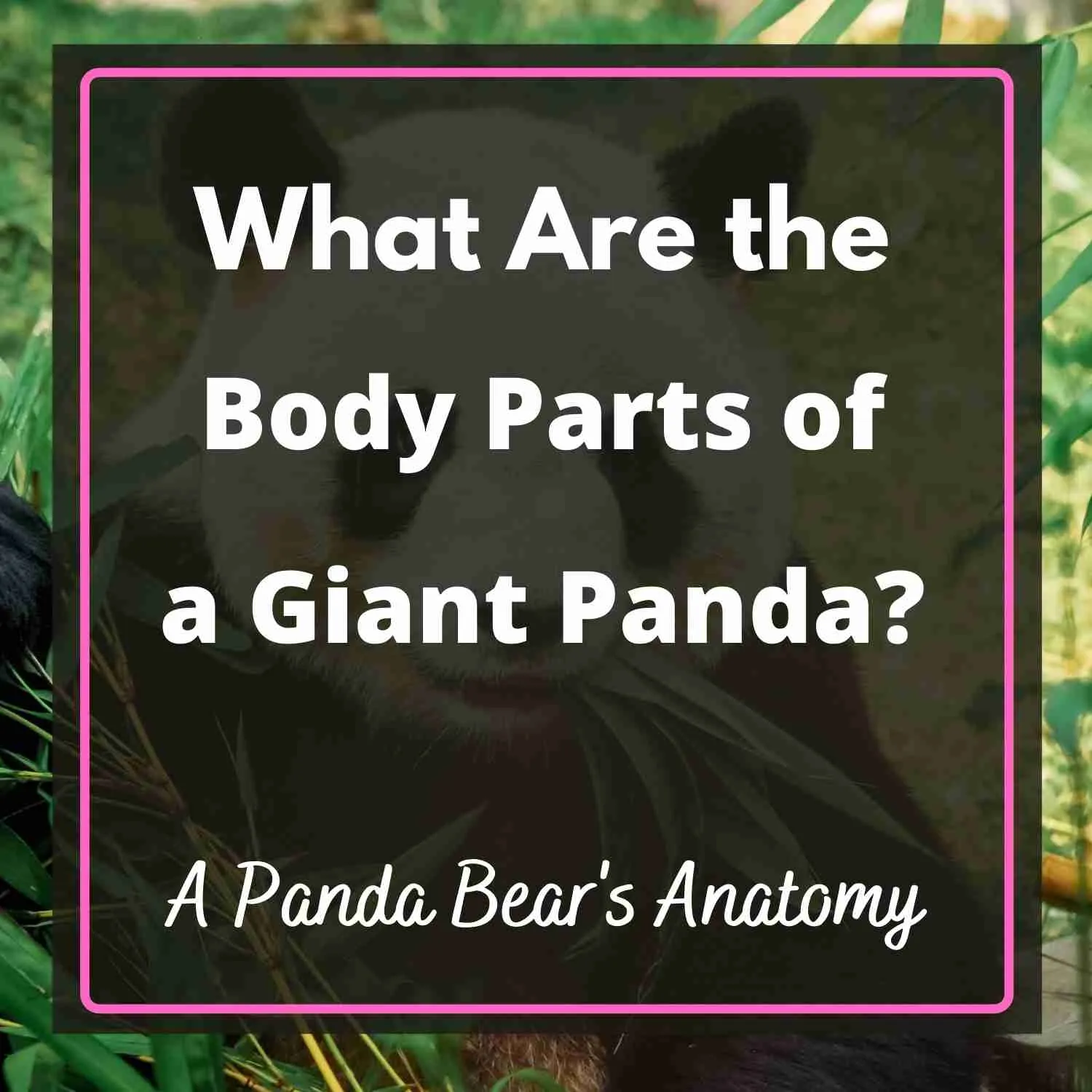When it’s something as cute as a giant panda bear, you can’t just stop until you know everything, right? You’re wanting to know almost everything about them, from their food, hobby, and even their body parts.
Have you ever wondered, what are the body parts of a panda bear?
Here’s a short answer – A giant panda has all the body parts of a typical mammal such as eyes, mouth, teeth, nose, snouts, ears, legs, arms, fingers, and tails.
Now that you know a little about it, maybe your next question now is – Why do pandas need this body parts for survival? Let’s dive in to know more!
What Are The Body Parts of the Panda?
The giant panda has all body parts that any animal would generally have. Their body parts have evolved through times. Moreover, these body modification were brought by their chosen life style. which is to change their diet from carnivorous to herbivorous state.
The giant pandas are known to be giant. But, are they really that giant? Well, let’s look into this.
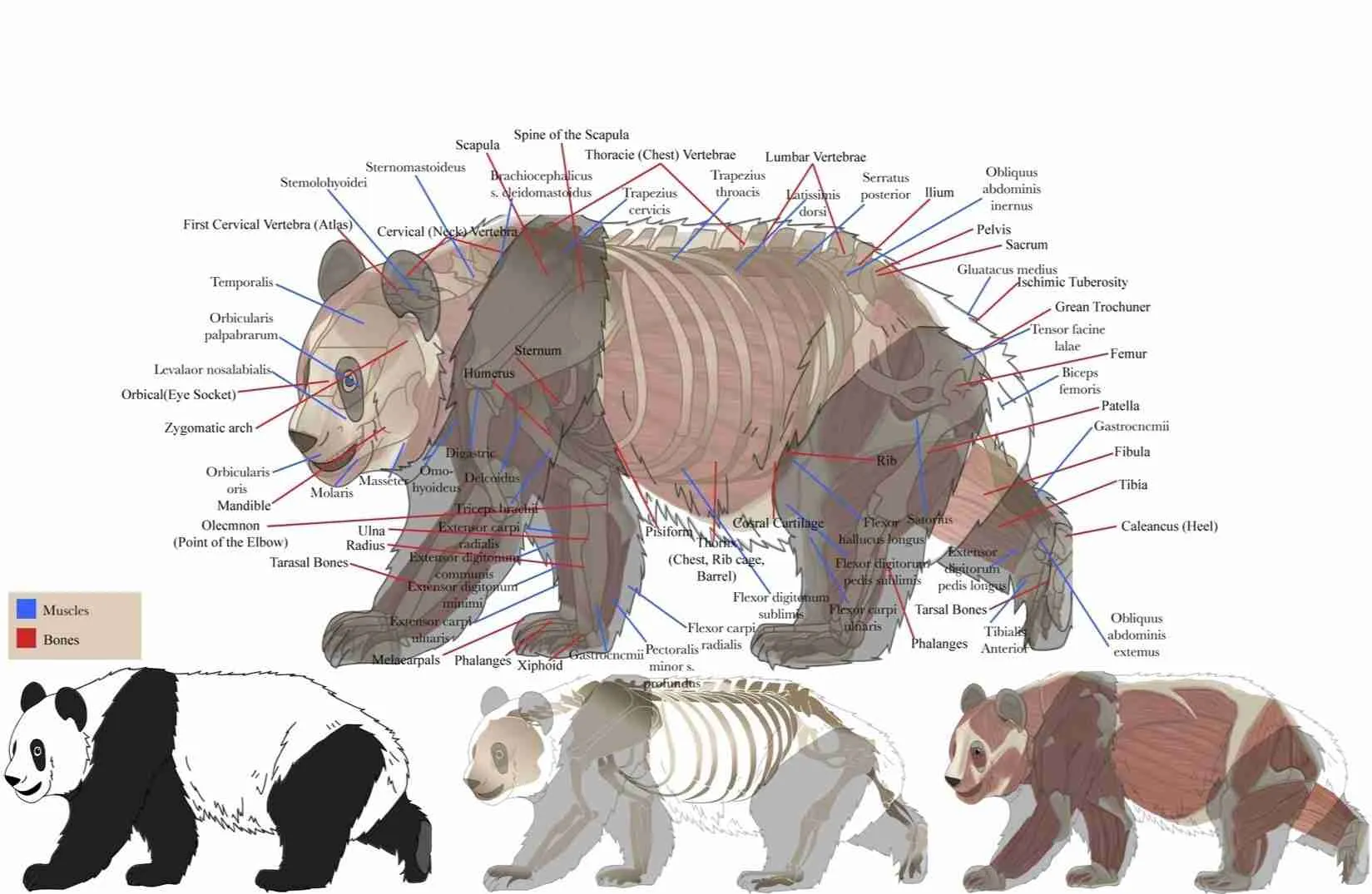
Typically, the giant panda’s body is 120 to 180 cm long. However, they are only 54 to 81 cm tall – which is half of the average human height. They are not as small as cats and not as large as elephants, too. But, they have the perfect size to cuddle with.
Moreover, the giant pandas have different body parts with particular functions to make them live and survive the life they are living. They also have adapted a more sluggish and lazy lifestyle.
A major reason behind this lifestyle is their dietary modifications. They could have gained higher amount of energy if they would fed on meat, but they chose not to do so. Therefore, to live and survive with sufficient amount of energy, they have to eat more bamboo and develop a more idle lifestyle.
On the latter part, we will have a broader look at all body parts and physical features. We will also talk about their significance for the lifestyle of a giant panda. So, let’s dig deeper.
What Are the Physical Features of the Giant Panda?
If we have a look at the physical features of a giant panda, we will find the following important parts:
I. Giant Pandas Have Tail
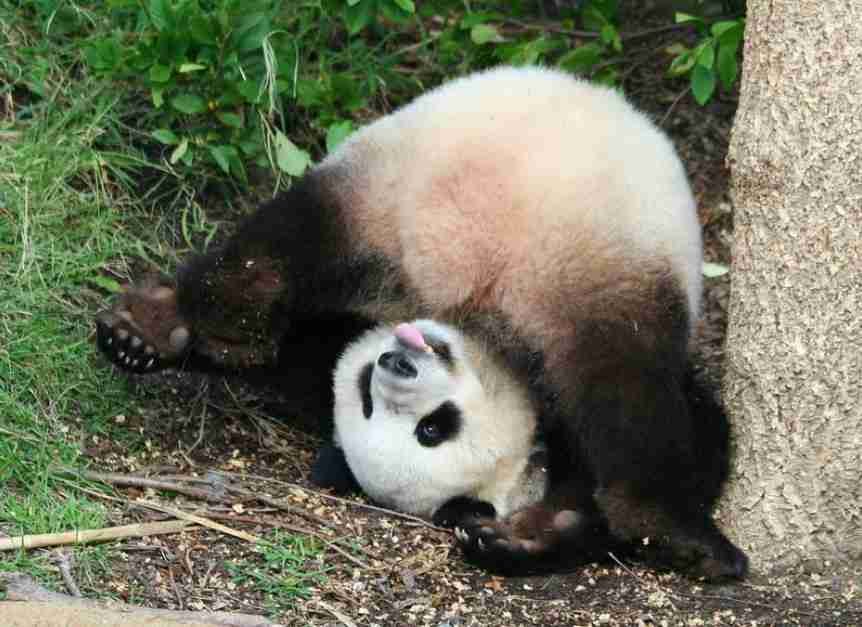
Do giant pandas even have tails? It’s a question that might take you by surprise. But it is important and imperative to be answered. So, let’s see if they actually have tails, and if they have, why didn’t we notice it before?
The giant panda tail is often overlooked because of the fact that it is very small in size as compared to the overall size of the giant panda body. It is around 4 to 6 inches in length, while the giant panda body weighs around 331 lbs.
Hence, on such a heavy body, a few inches long tail is very likely to be hidden out. Moreover, the fur on the giant panda’s body makes it more camouflaged.
If we speak of the color and how it looks like, the giant panda tail is white in color, which makes it somewhat visible and distinct on a black and white patterned body fur. In shape, it is essentially round and sticks close to the body to protect the gland that is responsible for the production of panda scent.
Why Do Giant Pandas Need A Tail?
The purpose of the giant panda tail is to cover the circumanal glands that are present near the anal region of the giant panda body. Nature has made everything for a purpose. No part of this animal body is futile or meant for nothing at all.
Furthermore, the purpose of these glands is to produce urine and excrete harmful substances. The same gland is very important to help giant pandas mate with their partners by finding them by their scent that is released by this gland. Also, the small tail tends to stay close to the body, and offers full protection to the glands.
II. Giant Pandas Have Thumbs

The next important body part that is obvious in any mammal’s body is the thumb. It can be one thumb or more. But what does a giant panda have in store for us in regards to its thumbs?
To break it to you, giant pandas definitely have thumbs to hold stuff, particularly bamboo and other eatables. A careful look at the giant panda hands indicates that they have opposable thumbs, much like humans.
How Many Thumbs Does A Giant Panda Have?
The giant pandas have two thumbs that are essentially opposite to each other. They have a natural thumb, five digits, and another pseudo thumb – or a sesamoid wrist bone that is grown to act as a thumb.
Typically, the sesamoid bone present in the giant panda wrists is considered as the second thumb. This is the evolution that makes the giant panda bears hold bamboo and other things quite easily.
Why Do Panda Bears Need A Thumb?
Although giant pandas were carnivores, in the beginning, they evolved out to be bamboo-eating animals. Considering it is bamboo, they needed strong gripping abilities to allow them to hold it.
Hence, to make it easier for them, they were evolved with opposable thumbs that can hold the stalks, fruits, vegetables, and other food items quite strongly. Since the digits are small, the two opposable thumbs play a very vital role in holding things.
III. Giant Pandas Don’t Have Whiskers

Whiskers look good on cats or red pandas. Have you ever wonder, if do giant pandas have whiskers too? Well, this doesn’t sound very comfortable on such fluffy and adorable animals.
If you are not comfortable with this notion, well, you are a true panda lover. Giant pandas actually don’t have whiskers – just as you were wondering. Instead, they have hair on their snouts, but they are non-sensory.
The fact that the snout hair has no sensory capabilities, we cannot quite call them whiskers. Because for whiskers, it is essential that they show some sensory or navigating activity. But the point is, do mammals have whiskers? Well, I don’t thinks so.
Hence, we can’t really call the giant panda snout hairs as whiskers but simple hair. Isn’t it make them more adorable?
Why Panda Bears Don’t Need Whiskers?
The point here is that since they don’t have whiskers, consequently, they don’t have the sensory capabilities to move around and protect themselves, then what is the alternative for them to protect themselves and move around?
Well, there are quite a few reasons as to why don’t they need whiskers. First things first, whiskers are sensory body parts that are meant to help in navigation and safety. Mostly the animals that have fast movements, such as cats, etc., need whiskers.
However, giant panda bears are very indolent and slow-paced animals. Even if they can sense something as close as to their snouts, it is impossible that they run away from their predator.
Therefore, they need a mechanism that could help them sense danger from afar. This would allow them to make way for their protection before the danger is so near that they are unable to fight it off. Smart work, dear pandas!
What Do Pandas Use To Sense Their Environment?
Now that’s something we call concern. And your concern is a hundred and ten percent, right. But to ease out anxiety, giant pandas have a full-fledged mechanism to protect themselves from any danger in the surrounding environment.
The panda bears have a very good sense of smell that plays a very important role in protecting them from harm and dangers. It allows giant pandas smell things from a very large distance. Therefore, if they smell danger or any other animals in the vicinity, they tend to change their direction and hide somewhere else.
Moreover, they use the same ability to express emotions. The fellow panda bears are able to recognize and sense each other presence through this same mechanism. The circumanal gland that the tail protects has the property of producing a particular scent along with the excreta.
When the fellow panda bears sense the smell, they try to navigate closer to it until they reach and meet with another. This same process allows the giant panda bears to mate for the continuity of their species. How cute and lovely!
IV. Giant Pandas Have Belly Buttons
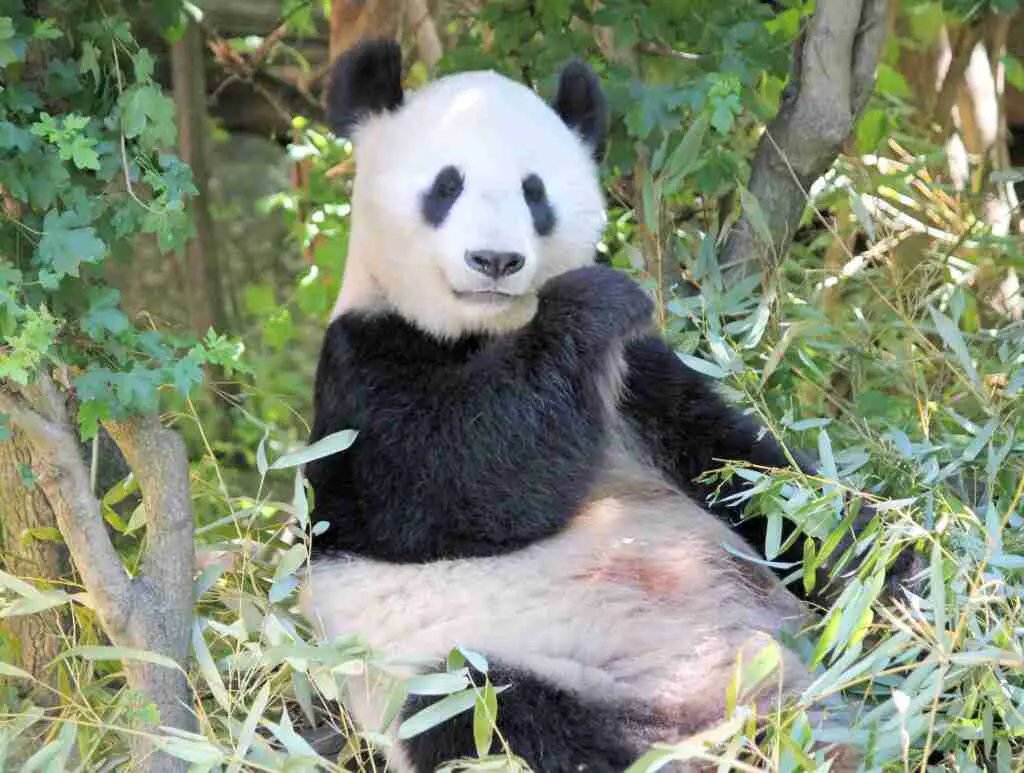
One of the common features of a mammal is their belly button. And it is very evident among giant pandas. You might have seen many giant panda stuff toys bearing belly buttons. Let’s know what these are for!
The giant pandas have belly buttons that mostly remain veiled inside their thick fluffy black and white fur. However, the point of significance is that they have bellybuttons like all mammals. It means that giant pandas are placental animals, and they supply food and nutrients to their babies in the womb through the umbilical cord.
The belly buttons are only the remains of the umbilical cords. Physiologically and anatomically, the giant panda belly buttons are quite insignificant. However, they have been quite vital in designating and determining the giant pandas as mammals due to the fact that, like other mammals, they also possess belly buttons.
How Do Pandas Break Their Umbilical Cord?
The panda cubs have umbilical cords in place of bellybuttons when they are born. However, soon after their birth, the panda mothers bite off their cords that make a scar for a while, and later we term it as the belly button.
Moreover, the reason for biting off is that the babies are very small, tiny, and fragile. Therefore, it is essential at that point to bite off any extra things of the body. Otherwise, they might get infected and cause trouble for the babies.
V. Giant Pandas Have Sharp Teeth

One of the fascinating facts about giant pandas is definitely their sharp teeth. At first, it sounds and seems like a shock and might upset you for a while. But when you research and study it, I am pretty sure you won’t get to hate the cute panda bears.
There is no denying the fact that the teeth might be quite intimidating to look at the giant panda jaws, but they don’t make them any less adorable. Or do they? Well, they never did in y case.
Provided that they are peace-loving animals, it really doesn’t matter if they have sharp teeth or they are teeth less. So, how many teeth do they have – 32 like humans? Let’s find out.
The giant pandas typically have 42 teeth (definitely more than humans) that consist of incisors, very sharp canines, large surfaced premolars, and molars. But do they need so many teeth just to chew on some tree stalks?
Definitely no. They have these teeth because of the fact that anatomically and metabolically, they are carnivorous animals. The fact that it is all controlled by genes, environmental factors don’t seem to do much in this case.
Furthermore, their teeth are essentially in the same way as other carnivorous mammals. The upper and lower jaws essentially follow the same patterns and contain all pairs of incisors, canines, premolars, and molars.
What Does A Giant Panda Teeth Look Like?
A one-word and straightforward answer that would do justice with the look of giant panda teeth will be “scary.” However, there is nothing exactly to be scared of. After all, they are cute, adorable, friendly, and very peaceful.

If we talk about what the giant panda jaws look like, they have very small incisors in the middle. Then there are two canines that are very sharp and strong. Next to the canines, they have premolars and molars.
Moreover, the purpose of all this set of teeth both on the upper and lower jaws, is to make sure that the giant pandas chew the food (bamboo) properly. Since their bodies are metabolically carnivorous, they need to chew the bamboo properly to help them digest it.
Why Do Panda Bears Have Canine Teeth?
What are carnivorous typically recognized from? They are canines, of course! As we all know that giant pandas are carnivores, and the carnivores feed on other animals – mainly by preying onto them. Hence, they have canines to hunt down their prey, crack its bones, and tear its flesh.
But since the giant pandas have moved to a more peaceful lifestyle out of fear of ferocious animals like lions and tigers, they don’t use their canines for that purpose anymore.
Now their sharp canines help them to break bamboo stalks and eat them by grinding properly between the upper and lower premolars and molars. See, there is nothing that we should be scared of. They are only eating their favorite food from the sharp canines – and that is bamboo.
How Strong Are Giant Pandas Teeth?
As far as the strength of giant panda teeth is concerned, they are so strong that they can easily crack the bones of other animals. You might often find a giant panda hunting on rats, rodents, and squirrels.
Although they don’t use strong teeth against other animals, if they wish to do so, they can very effectively utilize them against other ferocious animals to keep themselves safe from any attacks.
VI. Giant Pandas DON’T Have Pouches
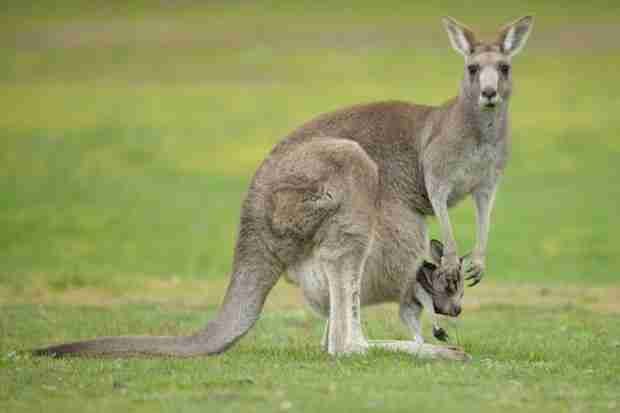
When we think of pouches, the first animal that comes to our mind is a kangaroo. Giant pandas do not have pouches, but kangaroos have. Let’s see why it is so!
Kangaroos are marsupial animals that keep their babies in their pouches until they fully grow and become independent. However, giant pandas are mammals, and they don’t possess pouches. Instead, they are placental animals that feed their babies within their placenta and umbilical cord.
They don’t essentially give birth to their babies. Until, they are fully developed and are able to live independently.
Why Do Panda Bears Don’t Have Pouches?
Pouched animals or marsupials essentially require pouches or “marsupium” for animals that have a short gestational period. The gestational period is when the baby remains within the mother’s body for the purpose of development and nourishment.
Moreover, the animals that have a short gestation period do not develop their babies properly. This is the case with marsupials or pouched animals. Since their babies are not fully developed, they need to carry them around even after their births.
On the other hand, giant pandas have a fairly long gestation period of 112 to 160 days which gives them sufficient time for their babies’ developmental steps. Hence, despite the giant panda babies’ small and tiny bodies, they are fully developed physiologically.
How Do Pandas Carry Their Babies?
You might have seen pictures of giant panda bears carrying their babies from the back. That’s true, and that’s definitely not cruel but a way of carrying their babies.
Giant panda mothers tend to keep their babies very close to their bodies. Since they are fully grown, the mothers don’t have to carry them in pouches. Sometimes, it may happen that the giant panda mother would carry their babies from their back with the help of its strong teeth.
Even though, the panda mother does it doesn’t hurt her baby. The giant panda mothers are very considerate, kind, and affectionate towards their cubs. They don’t let them out of their sight until they are independent and are able to get their food by themselves.
What Type Of Animals Have Pouches?
The animals that have short gestational periods have pouches. The reason is that their babies are underdeveloped when born. Therefore, they have to keep them in pouches until their development is completed.
Moreover, it is an effective way of protecting their babies. Such animals are known as pouched animals or marsupials. Some of these animals include kangaroos, koalas, wombats, and others.
VII. Giant Pandas Have Arms And Legs
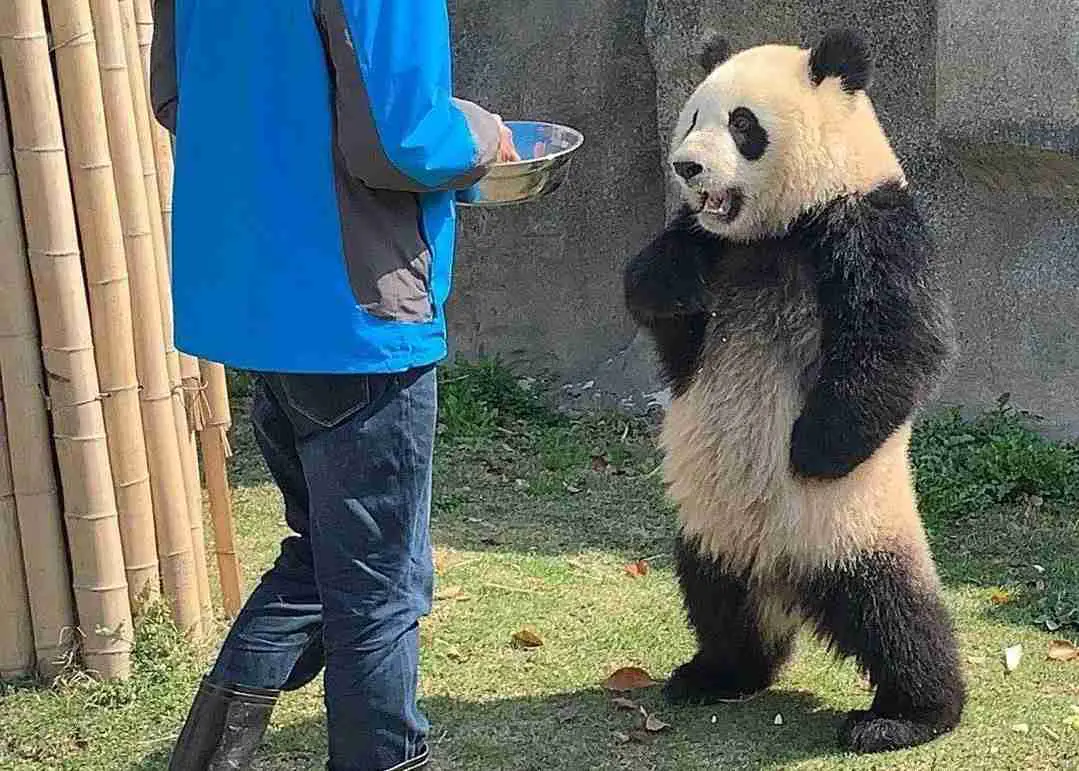
Like most mammals, giants pandas have four arms and legs. The two of them can be called arms, but essentially they are legs, and all four of them are involved in the movements. The arms and legs are essentially black in color to camouflage them in shadows. The average length of a giant panda’s arms and legs is 5 to 8 inches (12 to 20 cm).
Does A Panda Have 4 Legs?
Giant pandas typically have four limbs, and all four are used in the movement of giant panda bears. They are unable to stand on their hind legs. Hence, we can consider their arms as legs as well that help them to move around or stand. They look so adorable and cute while walking on all four of their legs.
VIII. Giant Panda Have Fingers
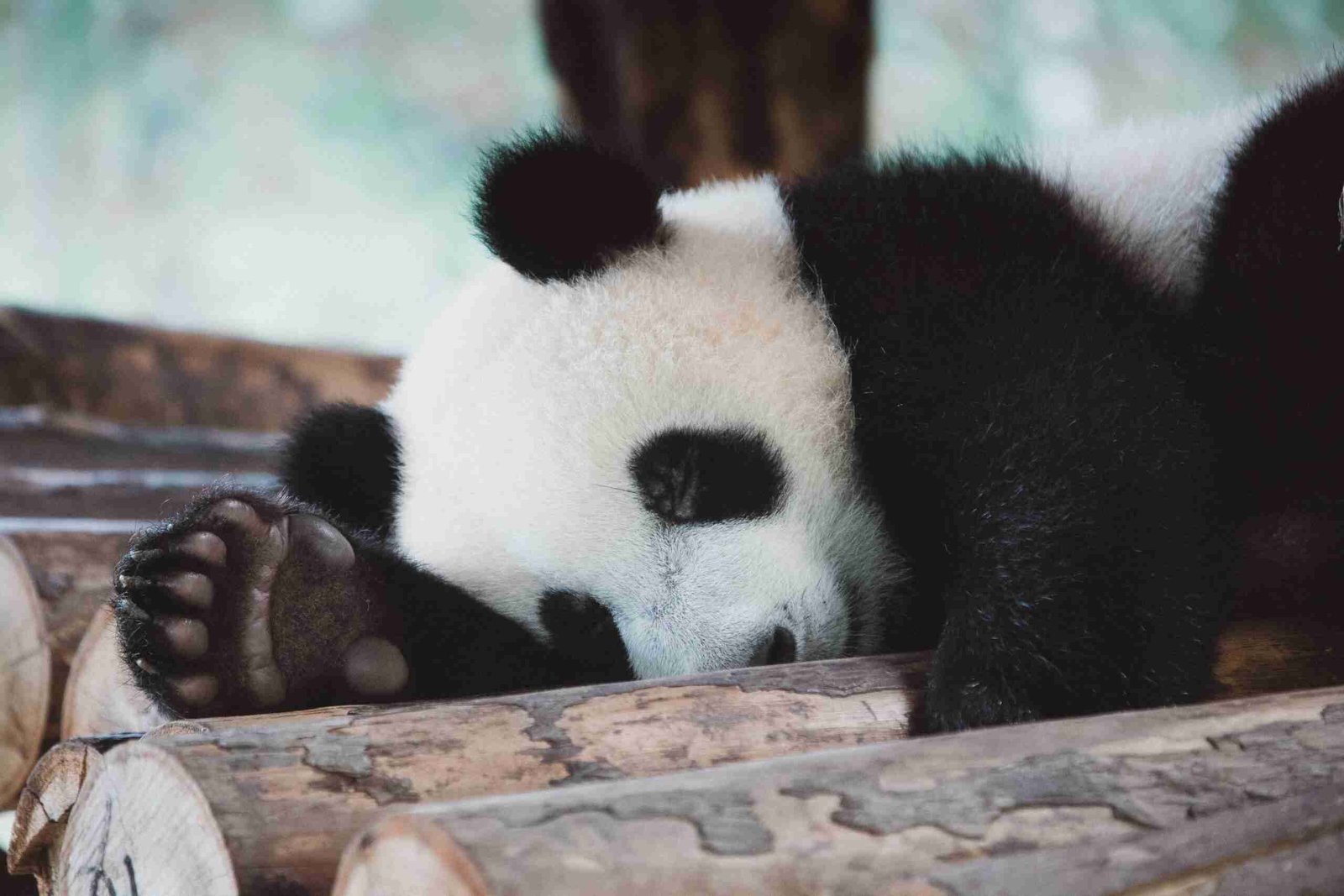
Giant pandas are mammals and have quite a lot of features similar to humans. However, when it comes to paws or hands, they are a bit different in numbers as well as in structure. This can be attributed to the fact that humans don’t essentially have to hunt or get their food by hands. Let’s see how the fingers or digits are developed in the giant panda bodies.
How Many Fingers Does a Giant Panda have?
Giant pandas essentially have six fingers or digits. However, one of these six is a pseudo thumb or an overgrown sesamoid bone. This thumb is opposable to the other thumb in the giant panda paws. The giant panda digits are covered from the fur on the upper part, but the inside shows the clear hierarchy of the digits.
The fingers have joints that allow the panda bears to fold them and hold anything with as much ease as possible.
Why Do Panda Bears Need Fingers?
Giant panda bears mostly rely on bamboo stalks and their leaves. Therefore, they need to make a firm holding of the stalks. The opposable thumbs and fingers allow them to hold the stalks as well as get them from the trees.
Moreover, they can move past bushes and trees by using their fingers. The fingers also let them have a firm grip on the ground. The fact that the joints allow them to adjust fingers on any surface, the giant pandas have very significant gripping abilities.
What Body Parts Do Giant Pandas Use for Survival?
As far as the giant panda survival is concerned, they essentially survive by using different physical features. The way giant pandas are physical says a lot about their survival. Although giant pandas are carnivorous animals, they are very peace-loving and try to avoid any fight as much as they can. However, for their survival, they have adapted their bodies in the following ways:
Furs to Keep them Camouflage from Predators
The thick, velvety fur keeps the giant pandas warm during very extreme weather conditions. Moreover, it prevents them from any forceful impact. Moreover, the black and white fur helps to keep them hidden within the atmosphere and environment of the forest. Therefore, fur plays a very important role in the survival of giant pandas, in addition to providing them a cute adorable look.
Teeth to Attack in case of Emergency
After fur, the most obvious body part that ensures giant panda survival is their teeth. The teeth are undoubtedly dangerous and can effectively kill the predator if any other animal tries to attack panda bears. It’s a different story, however, that the giant pandas would never initiate the attack.
On top of that, the premolar and molars have very large surface areas for proper grinding of bamboo stalks and leaves. This makes them easier to digest without the presence of any enzymatic or metabolic activity. Without these teeth, the giant pandas wouldn’t have been able to get the little amount of energy from bamboo that they are able to extract now.
Tail to Protect the Scent Producing Gland
Although tail does not actively take part in the survival of giant pandas, it is quite important. The fact that it covers the circumanal glands, which produce a particular scent to help giant pandas navigate around, is enough evidence to accept it as a body part ensuring survival. Had it not been for the tail and circumanal glands, the giant pandas wouldn’t have been able to mate and increase their species count.
Conclusion:
In this article, you have learned the different body parts of the giant panda, as well as, their functions and importance. Just like all the other animals, the body parts of giant pandas are very useful for them in one way or the other.
It is undeniable that giant pandas are very cute animals. They are not only adorable to look at but also adorable to spend time with. They require very high food maintenance of their favorite food, which is bamboo.
Their bamboo eating characteristics have affected their body structures quite significantly. That is why, they have a lazy behavior. On the other hand, other body parts such as circumanal glands, furs, and teeth play a very important role in their survival.
What do you think of this article? Did you find it very informative? Don’t forget to share it with your friends.

